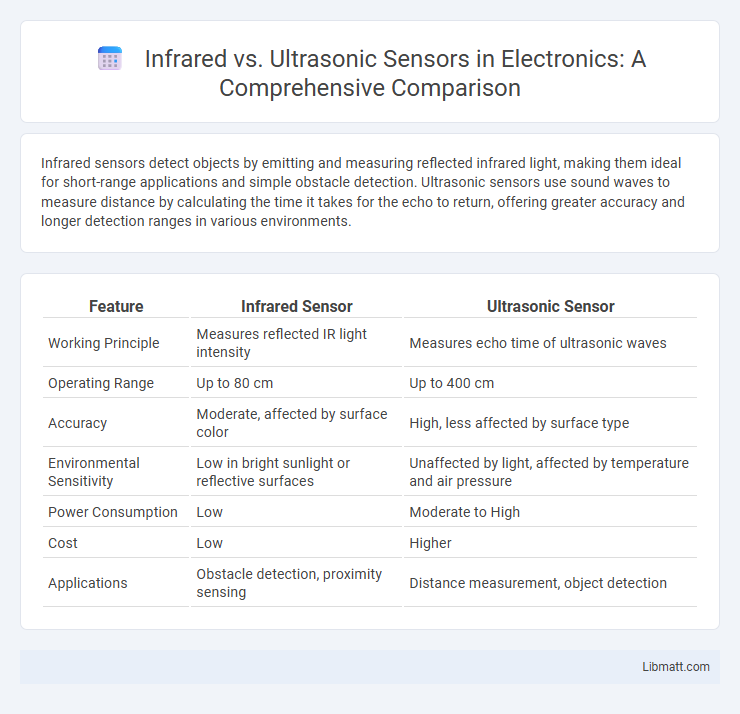Infrared sensors detect objects by emitting and measuring reflected infrared light, making them ideal for short-range applications and simple obstacle detection. Ultrasonic sensors use sound waves to measure distance by calculating the time it takes for the echo to return, offering greater accuracy and longer detection ranges in various environments.
Table of Comparison
| Feature | Infrared Sensor | Ultrasonic Sensor |
|---|---|---|
| Working Principle | Measures reflected IR light intensity | Measures echo time of ultrasonic waves |
| Operating Range | Up to 80 cm | Up to 400 cm |
| Accuracy | Moderate, affected by surface color | High, less affected by surface type |
| Environmental Sensitivity | Low in bright sunlight or reflective surfaces | Unaffected by light, affected by temperature and air pressure |
| Power Consumption | Low | Moderate to High |
| Cost | Low | Higher |
| Applications | Obstacle detection, proximity sensing | Distance measurement, object detection |
Introduction to Infrared and Ultrasonic Sensors
Infrared sensors detect objects by emitting infrared light and measuring the reflected signals, making them effective for short-range detection and proximity sensing. Ultrasonic sensors use high-frequency sound waves to calculate distance based on echo time, providing precise measurements over longer ranges and in various lighting conditions. Your choice between these sensors depends on the environment and required detection accuracy, as infrared sensors excel in clear line-of-sight scenarios while ultrasonic sensors perform better in dark or dusty conditions.
How Infrared Sensors Work
Infrared sensors operate by emitting infrared light and detecting the reflection to measure distance or presence of objects. The sensor's photodiode or phototransistor receives reflected infrared light, converting it into an electrical signal proportional to the object's proximity. This technology enables precise object detection in various applications such as obstacle avoidance and gesture recognition.
How Ultrasonic Sensors Operate
Ultrasonic sensors operate by emitting high-frequency sound waves that reflect off objects and return to the sensor, allowing precise distance measurement based on the time taken for the echoes to return. These sensors are highly effective in various environments because they detect objects regardless of color or transparency, unlike infrared sensors which rely on light reflection. Your applications can benefit from ultrasonic sensors when accurate, non-contact measurement and object detection in diverse conditions are required.
Key Differences Between Infrared and Ultrasonic Sensors
Infrared sensors use light waves to detect objects and measure distance, relying on reflected infrared radiation, while ultrasonic sensors emit sound waves and calculate distance based on the time taken for the echo to return. Infrared sensors are ideal for short-range detection in clear environments, offering fast response times and sensitivity to color and material, whereas ultrasonic sensors perform better in varying lighting conditions and can detect transparent or dark objects at longer distances. Your choice between these sensors should consider factors like detection range, environmental conditions, and object properties to ensure optimal performance.
Applications of Infrared Sensors
Infrared sensors are widely used in applications such as motion detection, proximity sensing, and temperature measurement due to their ability to detect heat signatures and measure infrared radiation. They are essential in security systems, automatic lighting controls, and consumer electronics like remote controls and touchless switches. Your projects benefit from their accuracy and low interference in environments requiring precise object detection or thermal monitoring.
Applications of Ultrasonic Sensors
Ultrasonic sensors are widely used in industrial automation for precise distance measurement and object detection in environments where optical sensors may fail due to dust or lighting conditions. They are essential in automotive parking assistance systems, enabling accurate obstacle detection to enhance vehicle safety. Additionally, ultrasonic sensors support liquid level monitoring in tanks and robotics for collision avoidance, providing reliable real-time data in complex operational settings.
Pros and Cons of Infrared Sensors
Infrared sensors offer advantages such as low cost, compact size, and effective short-range detection in controlled lighting environments, making them suitable for obstacle avoidance in robotics. However, their performance can be impaired by ambient light interference, limited range, and poor detection of transparent or shiny surfaces. These limitations necessitate careful application design and sometimes supplementing with other sensor types like ultrasonic sensors for improved accuracy.
Advantages and Limitations of Ultrasonic Sensors
Ultrasonic sensors offer precise distance measurement with excellent performance in various lighting conditions and can detect transparent or shiny objects that infrared sensors may miss. They provide a longer detection range, typically up to several meters, and are relatively unaffected by color or surface reflectivity, making them suitable for complex environments. Your choice to use ultrasonic sensors should consider their susceptibility to interference from environmental noise and limitations in detecting soft materials that absorb sound waves.
Performance Comparison: Range, Accuracy, and Reliability
Infrared sensors typically offer shorter range detection of up to 80 cm with moderate accuracy, making them ideal for close-proximity applications, while ultrasonic sensors provide longer detection ranges up to 5 meters with higher distance accuracy. In terms of reliability, ultrasonic sensors perform better in diverse lighting conditions and can detect transparent objects, whereas infrared sensors may struggle with ambient light interference. Choosing the right sensor depends on your specific needs for range, accuracy, and environmental stability in performance.
Choosing the Right Sensor: Infrared or Ultrasonic?
Choosing the right sensor depends on application requirements such as range, accuracy, and environmental conditions. Infrared sensors excel in short-range object detection and operate well in controlled lighting but struggle with transparent or shiny surfaces. Ultrasonic sensors provide longer range and better performance in varying lighting and foggy conditions, making them ideal for obstacle detection in robotics and autonomous vehicles.
Infrared vs Ultrasonic Sensor Infographic

 libmatt.com
libmatt.com